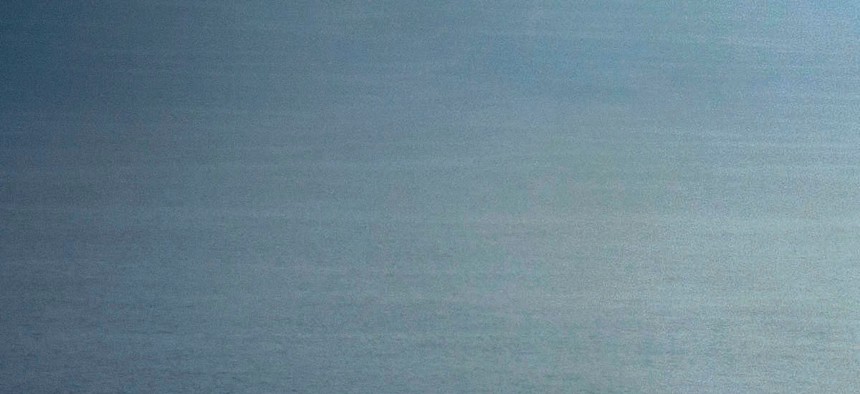
The future USS America and ships from the Peruvian navy sail in formation during a passing exercise in the Pacific Ocean. U.S. Navy photo by Mass Communication Specialist 2nd Class Ryan Riley
Hagel Visits Navy’s Newest Warship That Will Carry the F-35
The USS America is steaming the California coast for sea trials. By Marcus Weisgerber
ABOARD THE USS AMERICA – Defense Secretary Chuck Hagel visited the Navy’s newest warship Wednesday, a massive amphibious assault ship that could carry more than 3,000 sailors and Marines.
The ship, which is undergoing test trials about 10 miles off the California coast, is the first in a new class of amphibious ships designed to rapidly deploy Marines.
The America is “one of the most sophisticated Navy platforms we have,” Hagel told sailors while standing in front of a massive American flag in the ships hangar bay, which had flags of the 50 states hanging from the ceiling. The secretary is in the middle of a farewell tour, visiting Navy, Marine Corps, Air Force and Army posts across the country.
The America, which is about half the size of an aircraft carrier, is optimized for the Marine Corps newest aircraft, the F-35 Joint Strike Fighter and MV-22 Osprey.
On a typical deployment, about 30 aircraft will be onboard the ship. This would include a mix of F-35s or AV-8B Harriers, MV-22 Ospreys, attack and logistics helicopters and Navy combat search-and-rescue helicopters.
By comparison, about 90 planes fit on an aircraft carrier. The larger ships use a catapult system to propel fighter jets and small cargo and intelligence plane into the air. Planes can also land in a more traditional manner on the aircraft carrier. Planes must land vertically on amphibious assault ships. The Marine Corps is buying a special version of the F-35 that can land vertically and take off from the short flight decks of amphibious assault ships.
Unlike the Navy’s other amphibious assault ships, the America does not have a well deck, which allow small craft to float in and out of the ship’s stern. The absence of the well deck means the America has hangar deck that is 40 percent larger than older ships, allowing it to hold more aircraft. The larger hangar allows sailors to fix multiple aircraft at the same time. The extra space also means more room for maintenance support shops and extra aviation fuel tanks.
“It gives the Marines more flexibility and sustainability of the aircraft on the ship,” said Capt. Michael Wayne Baze, the ship’s executive officer.
This could allow aircraft to fly more missions off the America than smaller amphibious assault ships.
America is not likely to make a Western Pacific deployment until at least late 2016. At that time, it is possible that Marine Corps F-35s will deploy with the ship. The Pentagon is expected to declare the Marine version of the F-35 battle ready by the end of this year.
“There’s a good opportunity that the first or second deployment of this ship would have F-35s onboard,” Baze said.
The ship must still have its landing pads strengthened to handle the increased heat produced but powerful F-35 engines and Osprey rotors, Baze said.
At the same time, Navy officials are considering installing a 3D printer on the America to see how sailors could use the machine to make parts at sea, Baze said.
“Looking forward, I think that’s an enormous capability that it would bring to us from a logistics standpoint,” Baze said. “Getting things faster to us and then in the far-flung future being able to manufacturer things on the ship when we need it saves us storage room, it saves us time of equipment being down, all of that, which would be great.”
Last year, the Navy put a 3D printer on the amphibious assault ship Essex while in port.
